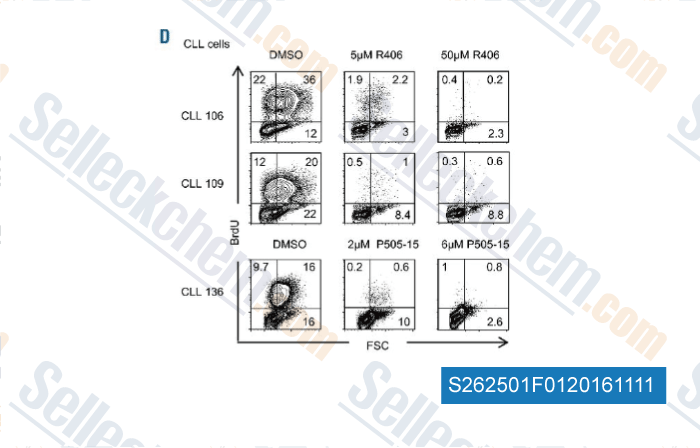|
Toll Free: (877) 796-6397 -- USA and Canada only -- |
Fax: +1-832-582-8590 Orders: +1-832-582-8158 |
Tech Support: +1-832-582-8158 Ext:3 Please provide your Order Number in the email. |
Technical Data
| Formula | C23H26FN6O9P |
|||
| Molecular Weight | 580.46 | CAS No. | 901119-35-5 | |
| Solubility (25°C)* | In vitro | DMSO | 116 mg/mL (199.84 mM) | |
| Water | Insoluble | |||
| Ethanol | Insoluble | |||
|
* <1 mg/ml means slightly soluble or insoluble. * Please note that Selleck tests the solubility of all compounds in-house, and the actual solubility may differ slightly from published values. This is normal and is due to slight batch-to-batch variations. * Room temperature shipping (Stability testing shows this product can be shipped without any cooling measures.) |
||||
Preparing Stock Solutions
Biological Activity
| Description | Fostamatinib (R788), a prodrug of the active metabolite R406, is a Syk inhibitor with IC50 of 41 nM, strongly inhibits Syk but not Lyn, 5-fold less potent to Flt3. Phase 3. | ||||||||
|---|---|---|---|---|---|---|---|---|---|
| Targets |
|
||||||||
| In vitro | R788 is a prodrug of the spleen tyrosine kinase (Syk) inhibitor R406. R788 is a competitive inhibitor for ATP binding with a Ki of 30 nM. R788 dose-dependently inhibits anti-IgE-mediated CHMC degranulation with an EC50 of 56 nM. R788 also inhibits the anti-IgE-induced production and release of LTC4 and cytokines and chemokines, including TNFα, IL-8, and GM-CSF. Inhibition of Syk by R788 results in inhibition of all phosphorylation events downstream of Syk signaling. Next to FcϵRI signaling in CHMC, R788 most potently inhibits the signaling of IL-4 and IL-2 receptors. R788 specifically inhibits FcγR signaling in human mast cells, macrophages, and neutrophils. R788 can inhibit local inflammatory injury mediated by immune complexes. [1] R788 induces apoptosis of the majority of examined DLBCL cell lines. In R788-sensitive DLBCL cell lines, R788 specifically inhibits both tonic- and ligand-induced BCR signaling (autophosphorylation of SYK525/526 and SYK-dependent phosphorylation of the B-cell linker protein [BLNK]). [2] | ||||||||
| In vivo | Oral administration of R788 to mice reduces immune complex-mediated inflammation in a reverse-passive Arthus reaction and two antibody-induced arthritis models. [1] In another study, R788 effectively inhibits BCR signaling in vivo, resulting in reduced proliferation and survival of the malignant B cells and significantly prolongs survival of the treated animals. [3] R788 demonstrates a significant reduction in major inflammatory mediators such as TNFalpha, IL-1, IL-6 and IL-18, leading to reduced inflammation and bone degradation in models of rheumatoid arthritis. [4] | ||||||||
| Features | Converted into its active metabolite R406 in vivo. |
Protocol (from reference)
| Kinase Assay: |
|
|---|---|
| Cell Assay: |
|
| Animal Study: |
|
References
Customer Product Validation

-
Data from [Data independently produced by , , Haematologica, 2016 Feb, 101(2): e59–e62.]
Selleck's Fostamatinib (R788) has been cited by 41 publications
| Spleen tyrosine kinase aggravates intestinal inflammation through regulating inflammatory responses of macrophage in ulcerative colitis [ Int Immunopharmacol, 2025, 148:114122] | PubMed: 39862635 |
| CpG oligonucleotides induce an acute murine thrombocytopenia dependent on toll-like receptor 9 and spleen tyrosine kinase pathways [ J Thromb Haemost, 2024, S1538-7836(24)00479-3] | PubMed: 39155024 |
| A semiconductor 96-microplate platform for electrical-imaging based high-throughput phenotypic screening [ Nat Commun, 2023, 14(1):7576] | PubMed: 37990016 |
| TLR7/8 stress response drives histiocytosis in SLC29A3 disorders [ J Exp Med, 2023, 220(9)e20230054] | PubMed: 37462944 |
| TLR7/8 stress response drives histiocytosis in SLC29A3 disorders [ J Exp Med, 2023, 220(9)e20230054] | PubMed: 37462944 |
| Syk Inhibition Reprograms Tumor-Associated Macrophages and Overcomes Gemcitabine-Induced Immunosuppression in Pancreatic Ductal Adenocarcinoma [ Cancer Res, 2023, 83(16):2675-2689] | PubMed: 37306759 |
| Syk-dependent alternative homologous recombination activation promotes cancer resistance to DNA targeted therapy [ Res Sq, 2023, rs.3.rs-2922520] | PubMed: 37333340 |
| Blockade of Syk modulates neutrophil immune-responses via the mTOR/RUBCNL-dependent autophagy pathway to alleviate intestinal inflammation in ulcerative colitis [ Precis Clin Med, 2023, 10.1093/pcmedi/pbad025] | PubMed: 37941642 |
| Establishment and Characterization of NCC-PMP1-C1: A Novel Patient-Derived Cell Line of Metastatic Pseudomyxoma Peritonei [ J Pers Med, 2022, 12(2)258] | PubMed: 35207746 |
| Establishment and characterization of NCC-UPS4-C1: a novel cell line of undifferentiated pleomorphic sarcoma from a patient with Li-Fraumeni syndrome [ Hum Cell, 2022, 10.1007/s13577-022-00671-y] | PubMed: 35118583 |
RETURN POLICY
Selleck Chemical’s Unconditional Return Policy ensures a smooth online shopping experience for our customers. If you are in any way unsatisfied with your purchase, you may return any item(s) within 7 days of receiving it. In the event of product quality issues, either protocol related or product related problems, you may return any item(s) within 365 days from the original purchase date. Please follow the instructions below when returning products.
SHIPPING AND STORAGE
Selleck products are transported at room temperature. If you receive the product at room temperature, please rest assured, the Selleck Quality Inspection Department has conducted experiments to verify that the normal temperature placement of one month will not affect the biological activity of powder products. After collecting, please store the product according to the requirements described in the datasheet. Most Selleck products are stable under the recommended conditions.
NOT FOR HUMAN, VETERINARY DIAGNOSTIC OR THERAPEUTIC USE.
